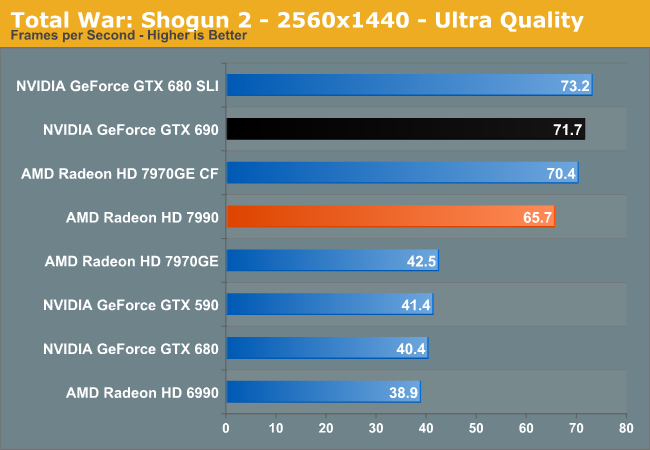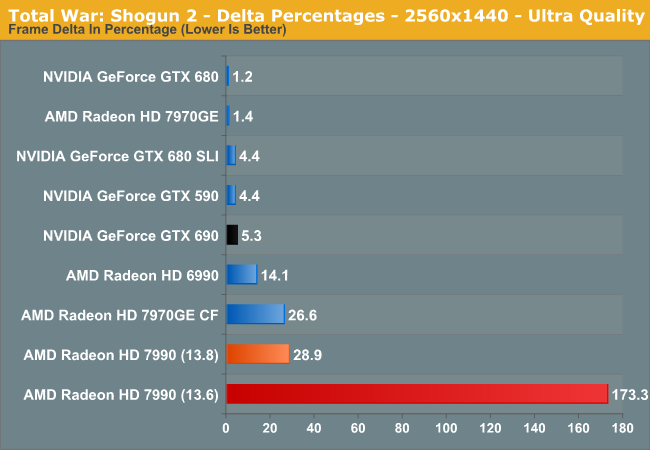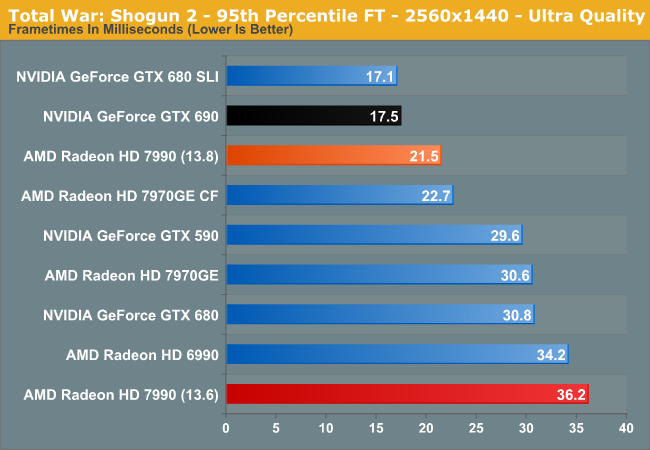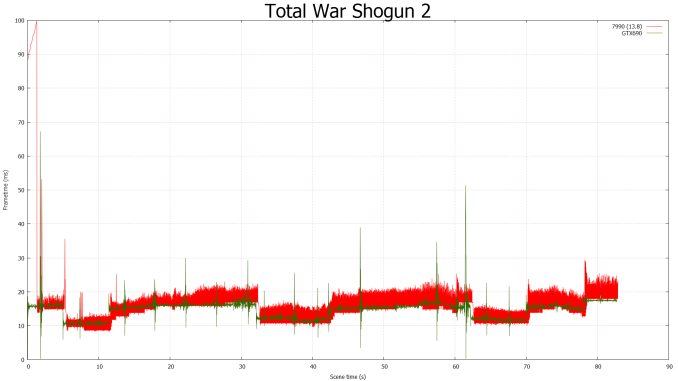AMD Frame Pacing Explored: Catalyst 13.8 Brings Consistency to Crossfire
by Ryan Smith on August 1, 2013 2:00 PM ESTTotal War: Shogun 2
Our first detailed benchmark is Shogun 2, which is a continuing favorite to our benchmark suite. Total War: Shogun 2 is the latest installment of the long-running Total War series of turn based strategy games, and alongside Civilization V is notable for just how many units it can put on a screen at once. Even 2 years after its release it’s still a very punishing game at its highest settings due to the amount of shading and memory those units require.

For the sake of completeness we’re posting our frame rate charts for each of our individual games, but in general there’s nothing here we haven’t seen before in the 7990 review, in other reviews, or in Bench. The 7990 and GTX 690 still swap places fairly regularly.

Looking at our expanded delta percentages for Shogun, we can see how the 7990 and other Crossfire solutions stack up to the GTX 690 and other SLI solutions. For all AFR configurations the results match what we saw in our summary, with NVIDIA’s solutions offering lower deltas than AMD’s even with the new drivers.
This is actually AMD’s weakest game, with both the 7970GECF and 7990 exceeding 20% variability on this game. However it’s also the only non-action game in this collection, so it’s the game least affected by higher levels of variation and consequently the game AMD can afford to do the worst at. Nevertheless the improvement over Catalyst 13.6 without frame pacing is nothing short of amazing.
Meanwhile we’ll hit upon this a few times, but as a reminder AMD’s frame pacing improvements apply to older cards too, so the 6990 has its frame pacing problems resolved like the rest of AMD’s multi-GPU cards. It actually does better than the rest, we believe due to the fact that the lower framerate and higher frame times give AMD’s drivers more time to analyze and schedule frames.
Looking at the FCAT graphs, we can see that the higher variability of the 7990’s frame times is represented well. Though NVIDIA’s frame time spikes are more extreme than AMD’s.

Finally we have our 95th percentile frame times. Despite the fact that AMD’s framerates are down slightly versus Catalyst 13.6, their 95% percentile times are way up. Simply by instituting frame pacing they’ve dropped from 36.2ms to 21.5ms per frame.











102 Comments
View All Comments
chizow - Friday, August 2, 2013 - link
Agree for the most part, but I wouldn't go as far to say boycott AMD, I'd say it's a good learning experience for AMD fans. In order to better their own products, they need to be forthcoming and honest about their experiences. If something's broken, demand a fix, don't sit there and dismiss or minimize the problem, or worst, deflect the issue toward the competition in denial. In the end, they just end up hurting themselves by gimping the products they enjoy.Will Robinson - Tuesday, August 13, 2013 - link
Please go back to spamming the comments section at Tech Report with your NVDA shill buddy Wreckage.Its beyond boring having to read it here too.
chizow - Friday, August 2, 2013 - link
Tom Petersen, Technical Marketing Director for Nvidia, has stated Nvidia has had built-in frame metering provisions since at least G80. Nvidia invented modern day AFR and they have clearly put a lot of thought behind it with the science to back it up. Every time you see them talk about AFR/microstutter/runtframes you see a lot of detailed technical slides and backup. Not so much from AMD. It should be obvious why Nvidia has had less of an issue with microstutter, they actually knew what they were looking to fix.http://techreport.com/review/22890/nvidia-geforce-...
"Nvidia's Tom Petersen threw us for a loop by asserting that Nvidia's GPUs have had, since "at least" the G80, a built-in provision called frame metering that attempts to counteract the problem."
Sabresiberian - Thursday, August 1, 2013 - link
Tech Reports is a competing company to AMD?While it is very good to see AMD making progress here, it is far from over for both AMD and Nvidia. Both companies have work to do to get frame rates to be consistent and high.
BryanDobbins - Saturday, August 17, 2013 - link
my neighbor's mom makes $72/hour on the internet. She has been unemployed for 7 months but last month her pay check was $19114 just working on the internet for a few hours. Read more on this web site... http://goo.gl/qHdAQ4Mondozai - Thursday, August 1, 2013 - link
Always liked Ryan's articles but I hope he gets to write more for this site in the future. For example, he should write more about mobile GPU's now that that area is gaining importance(this year we get to see PowerVR's newest generation, Rogue and next year we get to see Kepler in Tegra 5). Yet he didn't write anything on Tegra 5's Kepler story on this site even if he is the expert on GPU's.Doing a story on AMD drivers is all well and good but honestly, would like to see moar.
Ryan Smith - Thursday, August 1, 2013 - link
We have some in-depth mobile coverage scheduled for later this year, though I can't go into any more detail on it at this moment.mwildtech - Thursday, August 1, 2013 - link
Great write up! Thanks Ryan!SeeManRun - Thursday, August 1, 2013 - link
It wasn't totally clear from reading, but is there any point in upgrading to this driver if you have a single graphics card? It doesn't appear so.DanNeely - Thursday, August 1, 2013 - link
Release notes aren't out yet; but the 3rd page mentions that it adds full OpenGL ES 3.0 support as well as other not yes specified improvements. Most likely they include the obligatory few games to get a performance boost; but it's not purely a crossfire update.